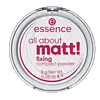What's inside
What's inside
 Key Ingredients
Key Ingredients

 Benefits
Benefits

 Concerns
Concerns

 Ingredients Side-by-side
Ingredients Side-by-side

Talc
AbrasiveMagnesium Stearate
Cosmetic ColorantMica
Cosmetic ColorantPolyethylene
AbrasivePetrolatum
EmollientPhenyl Trimethicone
Skin ConditioningDimethicone
EmollientPolybutene
Isostearyl Neopentanoate
EmollientEthylhexyl Methoxycinnamate
UV AbsorberTocopheryl Acetate
AntioxidantMethylparaben
PreservativeCocos Nucifera Oil
MaskingParaffinum Liquidum
EmollientPropylparaben
PreservativeParfum
MaskingAloe Barbadensis Leaf Extract
EmollientBenzyl Salicylate
PerfumingCitronellol
PerfumingHexyl Cinnamal
PerfumingLinalool
PerfumingBHT
AntioxidantIron Oxides
CI 77891
Cosmetic ColorantTalc, Magnesium Stearate, Mica, Polyethylene, Petrolatum, Phenyl Trimethicone, Dimethicone, Polybutene, Isostearyl Neopentanoate, Ethylhexyl Methoxycinnamate, Tocopheryl Acetate, Methylparaben, Cocos Nucifera Oil, Paraffinum Liquidum, Propylparaben, Parfum, Aloe Barbadensis Leaf Extract, Benzyl Salicylate, Citronellol, Hexyl Cinnamal, Linalool, BHT, Iron Oxides, CI 77891
 Reviews
Reviews

Ingredients Explained
These ingredients are found in both products.
Ingredients higher up in an ingredient list are typically present in a larger amount.
Magnesium Stearate is a salt that is 2 parts stearic acid and 1 part magnesium.
It is a white powder that can be used to add bulk and color to products by binding to oil ingredients.
Talc is a clay mineral. It helps absorb moisture and improve the texture of products. Like other types of clay, Talc can have a slight exfoliating effect on skin. Talc can be added to increase the volume of products.
Some Baby powders are made by combining talc with corn starch. The word "talc" comes from Latin and originates from Arabic. Talc is a mineral commonly found throughout the world.
If you have any concerns about using talc, we recommend checking out the FDA's official page.
Learn more about Talc